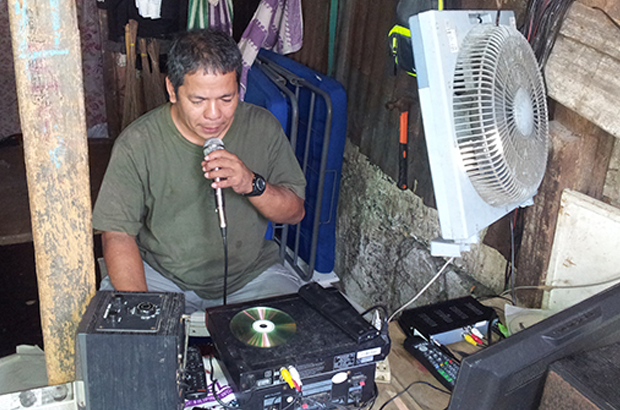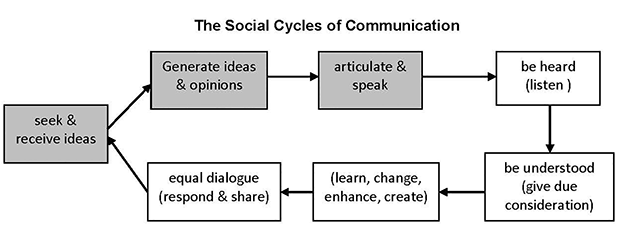13 Feb 2016 From theory to practice: The right to communicate

Radio San Roque, Quezon City, Philippines, run by the Pinoy Media Center, whose goal is to address the real issues facing poor communities, including urban and rural poor and indigenous people. Photo: Seán Ó Siochrú.
In 2015 I was lucky enough to be chosen by WACC to evaluate its small-grants programme, under which development partners all over the world are annually selected for grants to implement communication-related projects and to build their capacities in this area.
The real pleasure, and privilege, was an opportunity to visit some of these partners; in my case three in the Philippines and three in the Democratic Republic of Congo, and for Bruce Girard, my friend and co-evaluator, three in Mexico.1 For me, it was a welcome opportunity to explore the concept of the right to communicate, as it is actually implemented on the ground, in a development context.
The concept is not new to me. I have written extensively on it2 and was among those who initiated and ran the CRIS campaign that had a significant impact on the World Summit on the Information Society (WSIS), as well as in a few countries in stirring up campaigns and actions around communication rights.
I have also myself designed and evaluated numerous development oriented projects. But this was the first time I could explore in depth how dedicated communication-related actions are built into the strategies of partners, many of whom work with the most extremely disadvantaged and oppressed people anywhere.
The concept of communication rights by now has quite a respectable literature, and a considerable armoury of arguments for why the right to communicate should, in principle, be acknowledged as a necessary deepening and expansion of other human rights – in the first instance the right to freedom of expression as contained in for instance Article 19 of the Universal Declaration of Human Rights.
Amid ongoing concentration of corporate media ownership and the virtually total commercial takeover of the Internet, their success in promoting a global neo-liberal agenda offers clear evidence of the power wielded by the “free speech” of those with the loudest megaphones.

A social cycle of communication
But the right to communicate is also more than this: it goes beyond ensuring that those currently excluded from the public domain can have their voices amplified – welcome and all as this would be. The right to communicate is, in the end, not just about being heard: it must also mean securing access to the information you need; and being listened to by those in power with due consideration for your views.
It is about enabling genuine dialogue on equal terms; and it is above all about a right to a response from power-holders to issues raised. This is illustrated by the diagram on the following page. The three grey boxes are usually associated with freedom of expression; the words in bracket are the expectations put on, or demands to, ruling elites (sometimes politely called “duty bearers”).
Freedom of expression can get you only so far, at most enabling you (and even this presupposes full access to the information, skills, education and language etc. needed) to articulate and express your concerns – with no guarantee that you will be heard, let alone listened to. Rather, securing an appropriate response demands that those in power listen; that your views are understood and considered; that elites are willing to learn and give up privileges (perhaps the most difficult one!); and that free and fair dialogue informs what to do.
The right to communicate is vindicated for people only when all these are in place. And these clearly presuppose a wide range of other “flanking” rights, from access to information, to the right to assembly, to educational, linguistic and cultural rights etc. What is unique about the concept of the right to communicate is that it pieces them all together in a mutually interdependent sequence, enabling ideas to become reality in a social cycle of communication.
The concept of the right to communicate “connects the dots” between these other rights, not with a claim to supersede them, but rather by enabling them to become, together, larger than the sum of the individual parts through the cumulative impact of them all.
So much for the theory. The question is whether the concept of communication rights can be used concretely by those on the ground to set in motion and animate a dynamic sequence that transforms the demands of those excluded into meaningful and appropriate responses – or whether it is just a theoretical construct, a way of rearranging other rights in a coherent, but nevertheless abstract way.3
My interest in the WACC small-grant partners was to explore what happens in practice; to see if the idea of communication rights could descend from theoretical and ideological levels and be applied by partners in their daily struggles. While all partners’ projects were focused on communication issues, broadly defined, did the specific idea of communication rights prove to be useful to them?
Implementing communication rights
Although WACC partners were all at some point in the programme introduced to the idea of communication rights, their reading of it depended on where they were coming from.
Some partners are what might be called mainstream media initiatives. They are usually established by journalists, but are moving into participatory approaches and advocacy based on a growing recognition that mainstream media tend to be compromised when reporting adequately on exclusion. An example was a radical weekly magazine run by a group of reporters, moving towards community activism and the recognition that only when people have their own media will their voices be heard.
In these cases, the idea of a right to communicate, beyond freedom of expression, mirrored closely their own journey, a parallel to what they were learning in practice. In their case, the communication rights terminology was embraced and is used. Freedom of expression was simply not enough and the broader idea of communication rights fitted the bill.
Other partners already deploy the terminology and operationalise it in different ways, primarily those involved in community media (who comprised the largest single group in the small-grants programme). A core understanding is already present (at the heart of the community media movement) that simple freedom of expression is not enough: media must be owned and shaped directly by communities if their voices are to genuinely represent their interests, and if they are to be disseminated to reach the wider public domain.
This is already a major advance on for example mainstream media and many human rights activists, even the more progressive of whom seldom go beyond demands for freedom of the press and for the right to access information.
Yet this use of communication rights covers only part of the story; the part that enables the articulation of ideas and gets voices out there. It does not usually extend to further action that might ensure that the voices are listened to, given due consideration, and can enter a process of dialogue. Making this happen often demands further steps, supporting mobilisation of communities and other forms of lobbying, advocacy, direct action, building dialogue and so forth, and only some community media at present see themselves going this extra distance.
Then there are the many WACC partners that are primarily activists or advocates, with no media background, supporting on the ground the mobilisation of marginalised communities. These are coming to communication tools and practices often for the first time and would have no awareness of the right to communicate but a deep knowledge of the many barriers facing communities in securing their right.
Several of these were very attracted to the idea of the right to communicate, recognising its potential for encompassing and relating together a variety of obstacles facing marginalised groups, and these were keen to look into the concept more deeply. This was the case, for instance, with one partner working very closely with indigenous groups and land-grabbing. But other non-media partners found that the concept, while interesting, did not resonate in their particular working environment, an example being an organisation involved in supporting and educating trade unions and workers in securing their rights.
Need for deeper understanding of communication rights
Thus overall, a lesson emerging is that there is considerable traction on the ground for the right to communicate and its deployment in certain contexts. A conclusion of the evaluation report was that WACC, though overall managing the programme very well, puts insufficient effort into deepening partners’ understanding of communication rights and providing tools that might enable them to operationalise them in their specific contexts, a point that WACC has taken on board.
With these in place, many of these projects might begin to broaden their vision a little, in terms of recognising the sequence of barriers faced by marginalised groups and the role that communication plays across many of them. They may choose to build their existing actions around communication rights and/or extend their area of action further towards these dimensions. They may also more clearly identify a need to collaborate with others involved in attempting to complete the “social cycles of communication”.
On this last point, the experience of the CRIS Campaign is relevant. Although primarily a campaign focused at the international level, in a couple of countries and due to strong local leadership, the CRIS campaign succeeded in becoming an umbrella concept. Two of these, Brazil and Colombia, are in Latin America – which is no coincidence as activism around communication issues tends historically to be very strong there.
The point, however, is that with minimal resources these national level campaigns managed to link together a number of actors, from community media, freedom of expressions, copying restrictions, linguistic rights, into a wider campaign under the frame of communication rights.
The potential for the right to communicate to form such a frame of reference should not be overstated. It is more relevant in some cases than others, at the level of individual groups struggling for change and at national level. But there is some good evidence that significant potential is there; that the practical deployment of the concept can assist NGOs and CBOs in their own strategies, as well as bringing more diverse groups together under a common umbrella at national or regional levels.
WACC, through its small-grants programme and wider resource provision and networking actions, is in a great position to provide real leadership to this and contribute to the emergence of a wider communication rights movement.
Notes
1. Hopefully the evaluation will be made public at some point, but enough to say now that myself and Bruce Girard overall were surprised, sometimes amazed, and heartened by what was achieved with such modest grants by these really committed partners. We are hugely grateful for their time and insights.
2. See for instance CRIS Campaign 2006 Assessing Communication Rights: A Handbook most of which I wrote (>http://centreforcommunicationrights.org/articles/cris-campaign-assessing-communication-rights-a-handbook>). It gives a good introduction to communication rights. Also Chapter 14: “Finding a Frame: Towards a Transnational Advocacy Campaign to Democratize Communication.” in Hackett, R. and Z. Yuezhi (2005) Global Mediation. Lanham, MD, Rowman & Littlefield Publishers. This puts the case for communication rights as a frame for campaigning. For a prepublication version see: https://www.researchgate.net/publication/284184069_Finding_a_Frame_Towards_a_Transnational_Advocacy_Campaign_to_Democratise_Communication._%282004%29
3. Even as an abstract construct, it can serve a useful purpose. For instance, in the WSIS the concept served for many as a useful “ideological umbrella” under which those with differing issues, from community media, to opposing ever more restrictive copyright CRIS campaign, to internet access, could gather. Most international human rights laws also serve similar ideological functions, in the war of ideas, since they are usually unenforceable.



Sorry, the comment form is closed at this time.